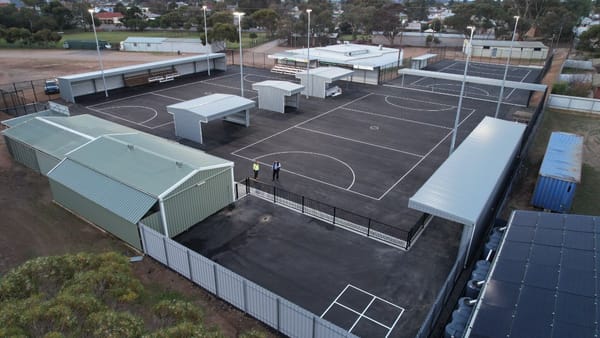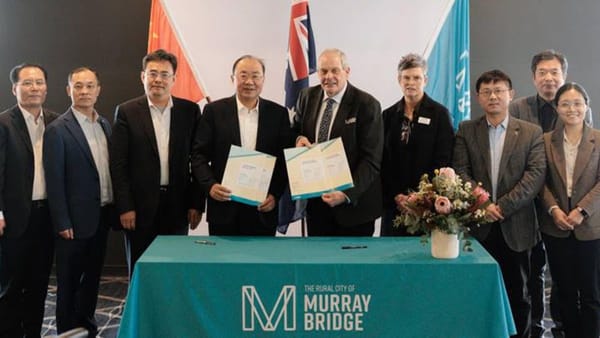Where to from here for the Murray-Darling Basin Plan? Five experts weigh in
Climate change? Water buybacks? Some old arguments are firing up again as a review of the all-encompassing plan for the River Murray approaches.

Locals support locals – that’s why this recent post is now free to read. Your support can help Murray Bridge News tell important local stories. Subscribe today.

The Murray-Darling Basin Plan is failing.
That’s the harsh truth that will face policy-makers over the next three years, as decades-old arguments about how to save the River Murray begin anew.
The basin plan, which determines how much water can be extracted from the river system and how much should be kept for the environment, is due to be renegotiated by 2026.
That negotiation won’t be easy, predicted five experts at an event in Adelaide on Friday night.
Despite last summer’s floods, they said, there just wasn’t enough water to go around – and climate change and a looming El Niño would only make things worse.
The Conservation SA event brought together Ngarrindjeri leader Grant Rigney, River Murray Commissioner Richard Beasley, Deputy Premier Susan Close, water economist Jeff Connor and Menindee farmer and advocate Kate McBride.
Together they argued that more needed to be done to keep the River Murray healthy into the future.
We’re aiming at the wrong target
When the basin plan was drawn up, Mr Beasley said, scientists had argued that an extra 4000 to 7000 gigalitres of water per year was needed to preserve the environment.
The figure the plan settled on, though, was 2750, with an option for another 450 on top of that and a few relatively minor adjustments agreed upon since.
The plan didn’t take climate change into account, either.

Mr Beasley suggested every degree of global warming would reduce the amount of water flowing into the system by 15 per cent.
Sea level rise would also threaten to inundate the Lower Lakes barrages in the coming decades, Mr Rigney warned.
Among the other problems the panellists found with the basin plan, and solutions they proposed, were:
- It might be unlawful: Mr Beasley, a barrister by trade, argued that the basin plan was “probably not constitutionally valid, and certainly unlawful”. That was because it accounted for social and economic factors, despite the federal Water Act saying it should be based only upon “the best available scientific knowledge”. The solution: legislative reform, or a major re-work of the plan.
- Nobody knows how many almond trees is too many: The problem with planting trees, rather than producing seasonal crops or livestock, is that you can’t scale back in dry years. The solution: governments shouldn’t tell people what to grow, Mr Beasley said, but they could regulate the number of trees people were allowed to put into a certain area.
- You can’t reduce environmental impacts to numbers on a scorecard: Mr Beasley described as “pseudoscience” the Murray-Darling Basin Authority’s use of an ecological scoring method to weigh up, for example, actions which might be good for trees but bad for native fish. Mr Rigney went further, arguing that the basin plan tried to turn everything into an asset or a commodity instead of recognising that everything was connected. The solution: have qualified scientists review the system.
- Indigenous expertise has been ignored: “Our knowledge is not seen as science,” Mr Rigney said. The solution: listen, or give Indigenous people a louder voice.
- Water theft: It’s the issue that sparked a royal commission in South Australia six years ago, and it hasn’t been solved yet. But the bigger problem, Professor Connor said, was “what you are allowed to take, not what you’re not allowed to take”. For example, the MDBA had no way of measuring floodplain harvesting: water collected before it flows into the river system, instead of being taken out. The solution: “This stuff can be monitored with modern technology, so there’s a lot of opportunities to tighten up,” Professor Connor said.
- Politics: The federal government, SA and the ACT were committed to the plan, and Queensland was generally supportive; but Ms Close said New South Wales and Victoria had been firmly opposed to buybacks or the extra 450GL. The solution: people power – we’ll get to that in a moment.

Want to save water for the environment? Buy it back
The cheapest and most efficient way of saving water was to buy it back, Friday night’s panellists suggested.
Irrigators own licences that allow them to use a certain amount of water each year, and the licences have a commercial value.
Governments can offer to buy the those water rights and assign them to the Commonwealth Environmental Water Holder, which uses the water to look after the environment.
Mr Beasley said the arguments against buybacks had been exaggerated.
Locals support locals. Your support helps Murray Bridge News tell important local stories.
“There’s no proportional relationship between an irrigator or farmer having less water and less farm production,” he said.
“People that sold water entitlements generally only sold part of their entitlements, so they didn’t leave farming; the money they got was often spent locally.”
Saving water by making infrastructure more efficient was 2.7 times more expensive than simply buying it back, Ms McBride said.
That extra money could be spent on regional hospitals and schools, she argued, creating jobs and better lives for kids in the bush.
The main reason people hadn’t embraced buybacks was fear, she said – and only because certain interests, notably National Party MPs upstream, had spent years warning against them.
The federal MP who represents the Murraylands and Riverland is dead set against them, too.

Buybacks would be like a ‘tax on food production’, Tony Pasin warns
MP Tony Pasin argued against buybacks in parliament in March.
“Taking this water out of productive use (would mean) destroying jobs in our regions and adding to cost-of-living pressures for all Australians,” he said.
“Less water available for production means higher prices for what water remains on the market, and lower production means higher prices in our shops.”
He described the federal government’s plans to secure the extra 450GL of water for the environment, and scrap the requirement for water savings to have no economic or social impact, as an “ideological crusade”.
South Australia’s fair share of 450GL worth of buybacks would amount to 38.5GL, he said – equal to a year’s worth of water for the Renmark irrigation district.
That would mean the loss of irrigation activity up and down the river, he said.
“Let’s achieve this plan in full, (but) let’s do it by providing an extension of time, let’s do it in a way that recovers the water for the environment but doesn’t do in the farmers in the process,” he said.

Basin plan ‘will only happen if people insist on it’, Deputy Premier says
At Friday’s event, however, Ms Close said the South Australian government recognised that buybacks would be needed for “significant, if not all” water savings.
She encouraged all South Australians to use every bit of influence they had to advocate for the River Murray.
“We need … one voice from South Australia saying ‘this plan must be delivered’, and we need everyone putting all of their effort into raising this issue,” she said.
“That will only happen if people insist on it.
“Be tough on politicians, including me … because that is the only way we’re going to get a sustainable Murray-Darling Basin.”
Ms McGuire, a parliamentary liaison officer by day, agreed.
In her experience, she said, MPs were empowered to get things done when their constituents gave them a barrage of visits, phone calls and letters.

Where to from here?
The Murray-Darling Basin Plan is due to be evaluated in 2025.
Changes will be recommended in a review in 2026; then it will be up to politicians to implement them.
MDBA chair Sir Angas Houston promised that the review would prioritise climate change, sustainable water extraction limits, involvement of Indigenous people, and the laws which regulate water use in the basin.
“This will be an opportunity to shape the future of basin water management into the 2030s,” he said.
“Everyone who wants to share their knowledge, views and ideas will have an opportunity to do so.
“With your help, we can make sure the basin plan continues to respond to the changing environment and the needs of our communities and industries, while we support our rivers for generations.”
- More information: www.mdba.gov.au/basinplanreview.
- Contact federal Environment and Water Minister Tanya Plibersek: Email minister.plibersek@dcceew.gov.au or call her in Canberra on (02) 6277 7920, or her Sydney electorate on (02) 9379 0700.
- Contact federal MP Tony Pasin: Email tony.pasin.mp@aph.gov.au, call his Murray Bridge office on 8531 2466 or visit the office at the Murray Bridge Green shopping centre.
- Contact state Climate, Environment and Water Minister Susan Close: Email officeofthedeputypremier@sa.gov.au or call 8226 8520.
- Contact state MP Adrian Pederick: Visit www.adrianpederick.com/contact_adrian.





